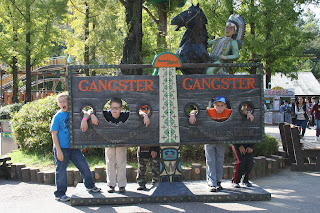 Bukhansan became a national park in 1983 and lies at the edge of Seoul. Bukhansan Mountain is covered in trees and granite outcroppings. Surrounded by cities, the park is an oasis to five million visitors each year. You can get the park by subway, bus, and car so it is a popular place for those in Seoul and the surrounding area.
Bukhansan became a national park in 1983 and lies at the edge of Seoul. Bukhansan Mountain is covered in trees and granite outcroppings. Surrounded by cities, the park is an oasis to five million visitors each year. You can get the park by subway, bus, and car so it is a popular place for those in Seoul and the surrounding area.We hiked to the top of Sapae Mountain on the Northern side of the park. It was a great escape from city life, and for a moment we were away from it all. Too bad the morning was hazy. We had a great view at the top.



















































